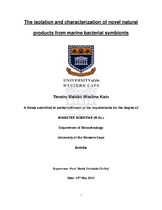| dc.description.abstract | Drug-resistant infections are a global health crisis and drastically hinder the treatment options to effectively combat disease. Today, natural products remain an important source of novel drug candidates. Micro-organisms, in addition to being a source of bioactive natural products, represent a sustainable source of these compounds. As the marine environment is largely underexplored, the oceans represent a potential source of novel NPs. This study aimed at the discovery of novel NPs from bacteria associated with novel marine invertebrate species endemic to the South African coast, including a sponge Spongia (Spongia) sp. 001RSASPN and a tunicate, Pseudodistoma africanum Millar, 1954. The methodology comprised of culture-dependent and culture-independent strategies. The former involved the isolation of bacteria associated with the invertebrate species and subsequent screening for anti-microbial activity against a panel of indicator strains including a multi-drug resistant E. coli strain. Anti-bacterial activity was detected in 6.1% and 4% of bacterial isolates from the sponge and tunicate isolates respectively. The culture-independent strategy involved the use of PCR to select bioactive strains likely to contain novel NRPS or PKS secondary metabolite pathways. An NRPS A- domain exhibiting low sequence identity (65%) to reference sequences in the NCBI database was amplified from isolate PE8-15, a strain belonging to the genus Bacillus. This predicted a novel NRPS pathway within this strain. In addition, this isolate exhibited the most diverse anti-microbial profile including anti-bacterial and anti-fungal activity (A.fumigatus ATCC 46645). Therefore, as the most promising candidate, the genome of PE8-15 was sequenced following which 10 secondary metabolite pathways including bacteriocins (5), NRPS (3), siderophore (1) and a terpene pathway were identified. The A-domain amplified from PE8-15 originated from Cluster 4, and NRPS pathway predicted to encode a lipopeptide. Lipopeptides are an important class of compounds with a range of industrial applications in the pharmaceutical, cosmetic as well as food industry. The identification of potentially novel secondary metabolite pathways from even well- studied groups of organisms demonstrates the importance of sequence-based methods in natural product discovery. Furthermore, this study highlights the South African coast as a rich source of microbial natural products and should be exploited further for drug discovery. | en_US |

